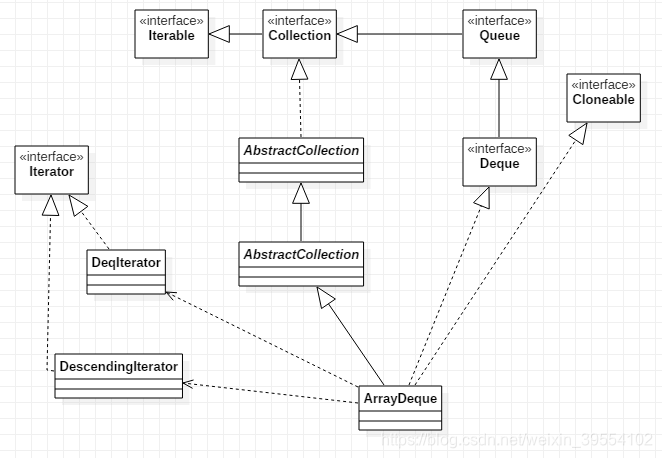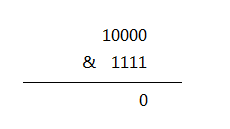JAVA集合 Deque 與 Queue 實現類 ArrayDeque(佇列、雙端佇列) 原始碼淺析
文章目錄
- JAVA集合 Deque實現類 ArrayDeque(雙端佇列) 原始碼淺析
- 一、簡述:
- 二、ArrayDeque 類結構與屬性
- 三、ArrayDeque 構造方法
- 四、Queue 的方法
- 五、Deque 的方法
- 7.新增到佇列頭 addFirst(E e)
- 8. addLast(E e)
- 9. getFirst()
- 10. getLast()
- 11. peekFirst()
- 12. peekLast()
- 13. pollFirst()
- 14.pollLast()
- 15.remove(Object o)
- 16.removeFirstOccurrence(Object o)
- 17.removeLastOccurrence(Object o)
- 18.removeFirst()
- 19.removeLast()
- 獲取長度 size()
- 判斷非空
- 清空 claer()
- 迭代器 Iterator
JAVA集合 Deque實現類 ArrayDeque(雙端佇列) 原始碼淺析
原始碼來自 JDK 1.8
原始碼註釋來自 java api 翻譯
一、簡述:
Deque 介面的大小可變陣列的實現。陣列雙端佇列沒有容量限制;它們可根據需要增加以支援使用。它們不是執行緒安全的;在沒有外部同步時,它們不支援多個執行緒的併發訪問。禁止 null 元素。此類很可能在用作堆疊時快於 Stack,在用作佇列時快於 LinkedList。
大多數 ArrayDeque 操作以攤銷的固定時間執行。異常包括 remove、removeFirstOccurrence、removeLastOccurrence、contains、iterator.remove() 以及批量操作,它們均以線性時間執行。
此類的 iterator 方法返回的迭代器是快速失敗 的:如果在建立迭代器後的任意時間通過除迭代器本身的 remove 方法之外的任何其他方式修改了雙端佇列,則迭代器通常將丟擲 ConcurrentModificationException。因此,面對併發修改,迭代器很快就會完全失敗,而不是冒著在將來不確定的時刻任意發生不確定行為的風險。
注意,迭代器的快速失敗行為不能得到保證,一般來說,存在不同步的併發修改時,不可能作出任何堅決的保證。快速失敗迭代器盡最大努力丟擲 ConcurrentModificationException。因此,編寫依賴於此異常的程式是錯誤的,正確做法是:迭代器的快速失敗行為應該僅用於檢測 bug。
此類及其迭代器實現 Collection 和 Iterator 介面的所有可選 方法。
此類是 Java Collections Framework 的成員。
二、ArrayDeque 類結構與屬性
uml

原始碼的class定義:
public class ArrayDeque<E> extends AbstractCollection<E>
implements Deque<E>, Cloneable, Serializable
{
transient Object[] elements; // non-private to simplify nested class access
transient int head; // 佇列頭索引
transient int tail; // 佇列尾索引
private static final int MIN_INITIAL_CAPACITY = 8; // 佇列初始化長度
private static final int MAX_ARRAY_SIZE = Integer.MAX_VALUE - 8; // 佇列最大長度
}
| 欄位 | 註釋 |
|---|---|
| elements | 儲存雙端佇列元素的陣列。 deque的容量是這個陣列的長度,它總是2的冪。 永遠不允許該陣列變滿,除了在addX方法中的瞬間,它在變滿時立即調整大小(參見doubleCapacity),從而避免頭尾纏繞到彼此相等。 我們還保證所有不包含deque元素的陣列單元始終為null。 |
| head | deque頭部元素的索引(即remove() 或pop() 將刪除的元素); 或者如果雙端佇列是空的,則任意數字等於尾部。 |
| tail | 將下一個元素新增到雙端佇列尾部的索引(通過addLast(E),add(E) 或push(E))。 |
| MIN_INITIAL_CAPACITY | 將用於新建立的雙端佇列的最小容量。 必須是2的冪。 |
| MAX_ARRAY_SIZE | 要分配的最大陣列大小。 一些VM在陣列中保留一些標題字。 嘗試分配更大的陣列可能會導致OutOfMemoryError:請求的陣列大小超過VM限制 |
三、ArrayDeque 構造方法
1、ArrayDeque()
原始碼註釋: 構造一個初始容量能夠容納 16 個元素的空陣列雙端佇列。
public ArrayDeque() {
elements = new Object[16];
}
2、ArrayDeque(int numElements)
原始碼註釋: 構造一個初始容量能夠容納指定數量的元素的空陣列雙端佇列。
public ArrayDeque(int numElements) {
allocateElements(numElements);
}
allocateElements(int numElements)
原始碼註釋: 分配空陣列,以儲存給定數量的元素。
private void allocateElements(int numElements) {
elements = new Object[calculateSize(numElements)];
}
calculateSize(int numElements)
原始碼分析: 這個方法以 2 的指數冪擴容 (8、16、32、64、128)
private static int calculateSize(int numElements) {
int initialCapacity = MIN_INITIAL_CAPACITY;
// Find the best power of two to hold elements.
// Tests "<=" because arrays aren't kept full.
if (numElements >= initialCapacity) {
initialCapacity = numElements;
initialCapacity |= (initialCapacity >>> 1);
initialCapacity |= (initialCapacity >>> 2);
initialCapacity |= (initialCapacity >>> 4);
initialCapacity |= (initialCapacity >>> 8);
initialCapacity |= (initialCapacity >>> 16);
initialCapacity++;
if (initialCapacity < 0) // Too many elements, must back off
initialCapacity >>>= 1;// Good luck allocating 2 ^ 30 elements
}
return initialCapacity;
}
3、ArrayDeque(Collection<? extends E> c)
原始碼註釋: 構造一個包含指定 collection 的元素的雙端佇列,這些元素按 collection 的迭代器返回的順序排列。
原始碼分析: 這裡的 allocateElements() 方法 和 addAll() 方法下面再解析;
public ArrayDeque(Collection<? extends E> c) {
allocateElements(c.size());
addAll(c);
}
四、Queue 的方法
1. 插入元素 add(E e)
原始碼註釋: 在此雙端佇列的末尾插入指定的元素。此方法等同於addLast。
如果指定的元素為null, NullPointerException
public boolean add(E e) {
addLast(e);
return true;
}
addLast(E e)
原始碼註釋: 在此雙端佇列的末尾插入指定的元素。此方法相當於新增。
原始碼分析: 關鍵程式碼:如何判斷佇列滿了, (tail = (tail + 1) & (elements.length - 1) == head, 即佇列頭等於佇列尾
這裡運用了二進位制運算的技巧, 因為這個佇列的長度是 2的n次方冪, 假設 16 的二進位制為 10000, 16 - 1後的二進位制是 1111;
所以 (tail + 1) & (elements.length - 1) 結果為 0; 10000 & 1111 = 0

public void addLast(E e) {
if (e == null)
throw new NullPointerException();
elements[tail] = e;
if ( (tail = (tail + 1) & (elements.length - 1)) == head)
doubleCapacity();
}
doubleCapacity()
原始碼註釋: 這個雙端佇列的容量增加一倍。 只有在滿員時才呼叫,即當頭尾索引變得平等時。
原始碼分析: 擴容後是原來容量的兩倍, System.arraycopy() 方法呼叫了兩次, 這是因為為了保留原來佇列元素的順序, 先將從 head 索引開始複製陣列, 再到從0 開始複製到索引tail處;
private void doubleCapacity() {
assert head == tail;
int p = head;
int n = elements.length;
int r = n - p; // number of elements to the right of p
int newCapacity = n << 1;
if (newCapacity < 0)
throw new IllegalStateException("Sorry, deque too big");
Object[] a = new Object[newCapacity];
System.arraycopy(elements, p, a, 0, r);
System.arraycopy(elements, 0, a, r, p);
elements = a;
head = 0;
tail = n;
}
2.插入元素 offer(E e)
原始碼註釋: 在此雙端佇列的末尾插入指定的元素。此方法相當於offerLast。
public boolean offer(E e) {
return offerLast(e);
}
offerLast(E e)
在此雙端佇列的末尾插入指定的元素。
public boolean offerLast(E e) {
addLast(e);
return true;
}
3.移除元素 remove()
原始碼註釋: 檢索並刪除此雙端隊列表示的佇列的頭部。 此方法與poll 的不同之處僅在於,如果此雙端佇列為空,則丟擲異常。
此方法等同於removeFirst。
public E remove() {
return removeFirst();
}
removeFirst()
原始碼註釋: 檢索並刪除此雙端佇列的第一個元素。 此方法與pollFirst的不同之處僅在於,如果此雙端佇列為空,則丟擲異常。
public E removeFirst() {
E x = pollFirst();
if (x == null)
throw new NoSuchElementException();
return x;
}
pollFirst()
原始碼註釋: 檢索並刪除此雙端佇列的第一個元素,如果此雙端佇列為空,則返回null。
public E pollFirst() {
int h = head;
@SuppressWarnings("unchecked")
E result = (E) elements[h];
// Element is null if deque empty
if (result == null)
return null;
elements[h] = null; // Must null out slot
head = (h + 1) & (elements.length - 1);
return result;
}
4.移除 poll()
原始碼註釋: 檢索並刪除此雙端隊列表示的佇列的頭部(換句話說,此雙端佇列的第一個元素),如果此雙端佇列為空,則返回null。
此方法等同於pollFirst。
public E poll() {
return pollFirst();
}
5.檢視元素 element()
原始碼註釋: 檢索但不刪除此雙端隊列表示的佇列的頭部。 此方法與peek的不同之處僅在於,如果此雙端佇列為空,則會丟擲異常。
此方法等同於getFirst。
public E element() {
return getFirst();
}
getFirst() 檢視佇列第一個元素
原始碼註釋: 檢索但不刪除此雙端佇列的第一個元素。 此方法與peekFirst的不同之處僅在於,如果此雙端佇列為空,則丟擲異常。
public E getFirst() {
@SuppressWarnings("unchecked")
E result = (E) elements[head];
if (result == null)
throw new NoSuchElementException();
return result;
}
6.檢視元素 peek()
原始碼註釋: 檢索但不刪除此雙端隊列表示的佇列的頭部,如果此雙端佇列為空,則返回null。
這個方法相當於peekFirst。
public E peek() {
return peekFirst();
}
peekFirst() 檢視第一個元素
原始碼註釋: 檢索但不刪除此雙端佇列的第一個元素,如果此雙端佇列為空,則返回null。
public E peekFirst() {
// elements[head] is null if deque empty
return (E) elements[head];
}
五、Deque 的方法
7.新增到佇列頭 addFirst(E e)
原始碼註釋: 在此雙端佇列的前面插入指定的元素。如果指定的元素為null,則為NullPointerException
public void addFirst(E e) {
if (e == null)
throw new NullPointerException();
elements[head = (head - 1) & (elements.length - 1)] = e;
if (head == tail)
doubleCapacity();
}
8. addLast(E e)
原始碼註釋: 在此雙端佇列的末尾插入指定的元素。這個方法相當於 add();
NullPointerException - 如果指定的元素為null
public void addLast(E e) {
if (e == null)
throw new NullPointerException();
elements[tail] = e;
if ( (tail = (tail + 1) & (elements.length - 1)) == head)
doubleCapacity();
}
9. getFirst()
原始碼註釋: 檢索但不刪除此雙端佇列的第一個元素。 此方法與peekFirst的不同之處僅在於,如果此雙端佇列為空,則丟擲異常。
NoSuchElementException - 如果此雙端佇列為空
public E getFirst() {
@SuppressWarnings("unchecked")
E result = (E) elements[head];
if (result == null)
throw new NoSuchElementException();
return result;
}
10. getLast()
原始碼註釋: 檢索但不刪除此雙端佇列的最後一個元素。 此方法與peekLast的不同之處僅在於,如果此雙端佇列為空,則丟擲異常。
NoSuchElementException - 如果此雙端佇列為空
public E getLast() {
@SuppressWarnings("unchecked")
E result = (E) elements[(tail - 1) & (elements.length - 1)];
if (result == null)
throw new NoSuchElementException();
return result;
}
11. peekFirst()
原始碼註釋: 檢索但不刪除此雙端佇列的第一個元素,如果此雙端佇列為空,則返回null。
如果此雙端佇列為空,則返回null
public E peekFirst() {
// elements[head] is null if deque empty
return (E) elements[head];
}
12. peekLast()
原始碼註釋: 檢索但不刪除此雙端佇列的最後一個元素,如果此雙端佇列為空,則返回null。
如果此雙端佇列為空,則返回null
public E peekLast() {
return (E) elements[(tail - 1) & (elements.length - 1)];
}
13. pollFirst()
原始碼註釋: 檢索並刪除此雙端佇列的第一個元素,如果此雙端佇列為空,則返回null。
public E pollFirst() {
int h = head;
@SuppressWarnings("unchecked")
E result = (E) elements[h];
// Element is null if deque empty
if (result == null)
return null;
elements[h] = null; // Must null out slot
head = (h + 1) & (elements.length - 1);
return result;
}
14.pollLast()
原始碼註釋: 檢索並刪除此雙端佇列的最後一個元素,如果此雙端佇列為空,則返回null。
public E pollLast() {
int t = (tail - 1) & (elements.length - 1);
@SuppressWarnings("unchecked")
E result = (E) elements[t];
if (result == null)
return null;
elements[t] = null;
tail = t;
return result;
}
15.remove(Object o)
原始碼註釋: 從此雙端佇列中刪除指定元素的單個例項。 如果雙端佇列不包含該元素,則不會更改。 更正式地,刪除第一個元素e,使得o.equals(e)(如果存在這樣的元素)。 如果此雙端佇列包含指定元素,則返回true(或等效地,如果此雙端佇列因呼叫而更改)。
此方法等效於removeFirstOccurrence(Object)。
public boolean remove(Object o) {
return removeFirstOccurrence(o);
}
16.removeFirstOccurrence(Object o)
原始碼註釋: 刪除此雙端佇列中第一次出現的指定元素(從頭到尾遍歷雙端佇列時)。 如果雙端佇列不包含該元素,則不會更改。 更正式地,刪除第一個元素e,使得o.equals(e)(如果存在這樣的元素)。 如果此雙端佇列包含指定元素,則返回true(或等效地,如果此雙端佇列因呼叫而更改)。
public boolean removeFirstOccurrence(Object o) {
if (o == null)
return false;
int mask = elements.length - 1;
int i = head;
Object x;
while ( (x = elements[i]) != null) {
if (o.equals(x)) {
delete(i);
return true;
}
i = (i + 1) & mask;
}
return false;
}
delete(int i)
原始碼註釋: 刪除元素陣列中指定位置的元素,根據需要調整head和tail。 這可能導致元件在陣列中向後或向前移動。
如果元素向後移動,則返回true
private boolean delete(int i) {
checkInvariants();
final Object[] elements = this.elements;
final int mask = elements.length - 1;
final int h = head;
final int t = tail;
final int front = (i - h) & mask;
final int back = (t - i) & mask;
// Invariant: head <= i < tail mod circularity
if (front >= ((t - h) & mask))
throw new ConcurrentModificationException();
// Optimize for least element motion
if (front < back) {
if (h <= i) {
System.arraycopy(elements, h, elements, h + 1, front);
} else { // Wrap around
System.arraycopy(elements, 0, elements, 1, i);
elements[0] = elements[mask];
System.arraycopy(elements, h, elements, h + 1, mask - h);
}
elements[h] = null;
head = (h + 1) & mask;
return false;
} else {
if (i < t) { // Copy the null tail as well
System.arraycopy(elements, i + 1, elements, i, back);
tail = t - 1;
} else { // Wrap around
System.arraycopy(elements, i + 1, elements, i, mask - i);
elements[mask] = elements[0];
System.arraycopy(elements, 1, elements, 0, t);
tail = (t - 1) & mask;
}
return true;
}
}
17.removeLastOccurrence(Object o)
原始碼註釋: 刪除此雙端佇列中最後一次出現的指定元素(從頭到尾遍歷雙端佇列時)。 如果雙端佇列不包含該元素,則不會更改。 更正式地,刪除最後一個元素e,使得o.equals(e)(如果存在這樣的元素)。 如果此雙端佇列包含指定元素,則返回true(或等效地,如果此雙端佇列因呼叫而更改)。
public boolean removeLastOccurrence(Object o) {
if (o == null)
return false;
int mask = elements.length - 1;
int i = (tail - 1) & mask;
Object x;
while ( (x = elements[i]) != null) {
if (o.equa
